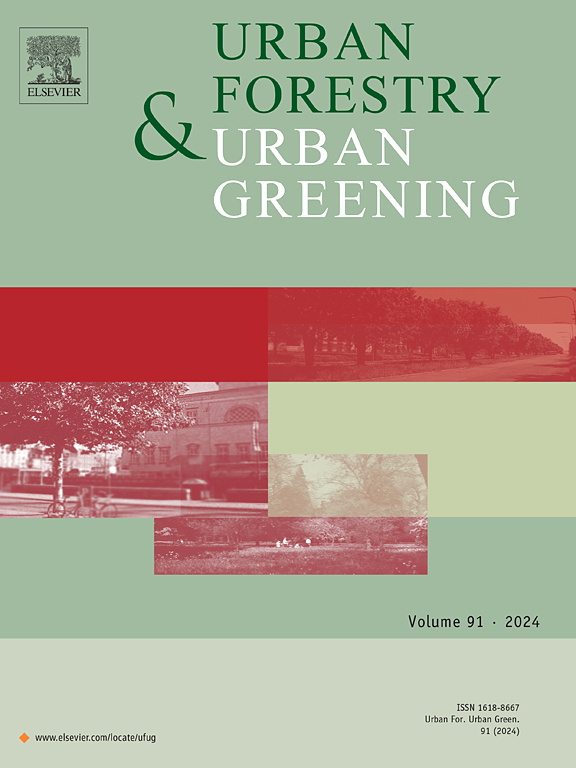针对城市灾害进行针对性绿色基础设施干预的特定树种适应性排序
IF 6
2区 环境科学与生态学
Q1 ENVIRONMENTAL STUDIES
引用次数: 0
摘要
绿色基础设施具有多种优势,可以有效应对城市灾害,增强城市韧性和可持续性。虽然传统的地理标志规划研究包含了它的多功能性,但它们往往局限于确定地理标志干预的优先位置,而没有探索如何响应当地的具体需求。本文以高度城市化城市郑州市为例,首先利用机器学习、遥感检索等方法,从城市洪水易感性、城市热环境和空气污染三个方面对城市灾害进行空间识别。随后,我们采用i-Tree生态模型来量化单一功能单元中潜在树种在解决这些城市危害方面的有效性。然后提出了一种适应性排序方法,将树种的有效性与当地应对城市灾害的需求相匹配。我们的研究结果表明,内城地区和西北地区应优先进行GI干预。城市灾害表现出显著的空间异质性,不同树种也有各自的优势,凸显了适应性决策的重要性。将研究区划分为3个区域,建议针对城市灾害采取最有效的GI干预措施,并在没有明显城市灾害的地区最大限度地发挥固碳潜力。该框架可为城市绿化工程的科学决策提供指导。本文章由计算机程序翻译,如有差异,请以英文原文为准。
Adaptive ranking of specific tree species for targeted green infrastructure intervention in response to urban hazards
Green infrastructure (GI), with its multifarious benefits, can effectively address urban hazards and enhance urban resilience and sustainability. While traditional GI planning studies incorporate its multifunctionality, they are often limited to identifying prioritized locations for GI intervention without exploring how to respond to the local specific demands. In this study, using a highly urbanized city, Zhengzhou as a case, we first spatially identified urban hazards in three aspects, including urban flood susceptibility, urban heat environment, and air pollution, utilizing machine learning, remote sensing retrieval. Subsequently, we employed the i-Tree Eco model to quantify the effectiveness of potential tree species in unitary functional units in addressing these urban hazards. An adaptive ranking approach was then proposed to match the effectiveness of tree species with local demands for addressing urban hazards. Our results indicate that the inner city area, as well as the northwest should be prioritized for GI interventions. Urban hazards exhibit significant spatial heterogeneity and different tree species also have specific advantages, highlighting the importance of adaptive decision-making. The study area is divided into three zones, and we suggest targeting urban hazards with the most effective GI intervention and maximizing carbon sequestration potential in areas without pronounced urban hazards. The developed framework can serve as guidance for scientific decision-making in urban greening projects.
求助全文
通过发布文献求助,成功后即可免费获取论文全文。
去求助
来源期刊

Urban Forestry & Urban Greening
FORESTRY-
CiteScore
11.70
自引率
12.50%
发文量
289
审稿时长
70 days
期刊介绍:
Urban Forestry and Urban Greening is a refereed, international journal aimed at presenting high-quality research with urban and peri-urban woody and non-woody vegetation and its use, planning, design, establishment and management as its main topics. Urban Forestry and Urban Greening concentrates on all tree-dominated (as joint together in the urban forest) as well as other green resources in and around urban areas, such as woodlands, public and private urban parks and gardens, urban nature areas, street tree and square plantations, botanical gardens and cemeteries.
The journal welcomes basic and applied research papers, as well as review papers and short communications. Contributions should focus on one or more of the following aspects:
-Form and functions of urban forests and other vegetation, including aspects of urban ecology.
-Policy-making, planning and design related to urban forests and other vegetation.
-Selection and establishment of tree resources and other vegetation for urban environments.
-Management of urban forests and other vegetation.
Original contributions of a high academic standard are invited from a wide range of disciplines and fields, including forestry, biology, horticulture, arboriculture, landscape ecology, pathology, soil science, hydrology, landscape architecture, landscape planning, urban planning and design, economics, sociology, environmental psychology, public health, and education.
 求助内容:
求助内容: 应助结果提醒方式:
应助结果提醒方式:


